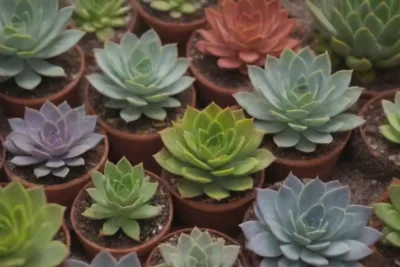
How to Care for Succulents in Windy Outdoor Locations

Introduction
Succulents have become increasingly popular in garden design due to their incredible variety and low maintenance requirements. While these resilient plants can thrive in various conditions, the outdoor wind can pose unique challenges that require specific care strategies. Understanding how wind affects succulents is crucial to ensuring their longevity and beauty.
In this article, we will delve into the essential aspects of caring for succulents situated in windy outdoor locations. We will explore how wind affects succulents, the best practices for protecting them, and tips for maintaining their health in such conditions. By the end of this guide, you’ll be equipped with practical knowledge to nurture your succulents, even in breezy environments.
Understanding the Impact of Wind on Succulents
When it comes to wind and succulents, several factors come into play that can impact their health and growth. Succulents have adapted to arid environments and possess thick, fleshy leaves that store water. Although resilient, strong winds can lead to several issues, including physical damage, dehydration, and stress.
Physical Damage
Wind can exert considerable force on fragile plants, especially for varieties with large or top-heavy growth. When wind blows, it can cause the stems and leaves to bend, break, or even uproot the plant entirely. Additionally, debris driven by the wind can strike succulents, leading to abrasions and wounds. Understanding this physical impact is vital for succulent owners in windy regions.
To combat physical damage, consider using windbreaks or protective barriers around vulnerable succulents. These can be made from natural or synthetic materials and are designed to shield plants from the direct force of the wind. Proper placement of these barriers can create a more stable micro-climate for your succulents, minimizing the risks associated with high winds.
Dehydration Risks
Interestingly, while wind can pose a risk of physical damage, it is also notorious for its role in dehydration, particularly during hot, breezy days. Wind increases the rate of evaporation of moisture from the soil and the plants themselves. For succulents, this can lead to severe water stress and wilting, even if the soil appears moist.
To prevent dehydration, it is essential to monitor the moisture level of the soil regularly. Using a moisture meter can help you accurately gauge when to water. Additionally, it’s beneficial to consider an appropriate watering routine that factors in wind exposure. Instead of deep frequent watering, you might opt for lighter, more regular watering sessions to ensure your succulents maintain hydration without overwhelming their roots.
 The Importance of Air Circulation: Ideal Succulent Placement
The Importance of Air Circulation: Ideal Succulent PlacementPlant Stress and Adaptation
Consistent exposure to windy conditions can also subject succulents to stress, making them more susceptible to diseases and pest infestations. When plants experience stress, their ability to thrive diminishes, leading to poor growth and, in some cases, death. Therefore, it’s important to recognize the signs of stress in your succulents, such as discoloration, wilting, and stunted growth.
To help your succulents adapt and minimize stress, consider providing a proper adaptation period. When introducing new plants to a windy environment, allow them to acclimatize gradually. Start them in a sheltered area and slowly move them to places with more significant wind exposure over days or weeks. This can help them adjust to the conditions without overwhelming their systems.
Best Practices for Protecting Succulents
Having established the impact of wind on succulents, let’s look at some best practices for caring for these hardy plants in windy outdoor locations. From strategic placement to appropriate potting choices, understanding these elements can make a difference in your succulents' health.
Strategic Placement
The first line of defense in protecting your succulents from wind is to strategically place them within your outdoor space. Look for locations that naturally offer some protection from prevailing winds, such as near walls, fences, or taller plants that can act as a natural barrier.
When planning your succulent garden, arrange taller or sturdier plants around your more delicate succulents. This layer of protection creates a microclimate that will help reduce the direct impact of the wind on the more sensitive plants.
It's also worth considering containers for your succulents. Placing your plants in pots allows you to reposition them as needed based on seasonal wind patterns. Choose pots with a wider base to provide additional stability, and consider heavier materials like ceramic or concrete to anchor the plants against gusts.
Soil and Watering Considerations
A well-draining soil mix is critical for succulents, especially in windy locations. Using materials like pumice, perlite, or sand will ensure that excess water does not accumulate, minimizing risks associated with overwatering while allowing moisture retention suitable for your plants.
 Creating the Perfect Succulent Shelfie for Instagram-Worthy Displays
Creating the Perfect Succulent Shelfie for Instagram-Worthy DisplaysWhen watering your succulents, pay attention to how the wind interacts with the moisture in the soil. You may need to adjust your watering schedule according to wind conditions; for instance, more frequent watering may be necessary after particularly dry, windy days to help replenish moisture levels.
Another water-retention strategy involves using mulch. Adding a layer of organic or inorganic mulch can help retain moisture in the soil while also protecting the pot from blowing debris. This can serve as an insulating barrier, aiding in temperature control for the roots while preventing rapid evaporation.
Windbreaks and Barriers
As previously mentioned, installing windbreaks can significantly improve your succulents' resilience against harsh conditions. When choosing windbreaks, consider materials that allow for air circulation while still providing adequate protection. Options include mesh fencing, burlap, or even strategically placed outdoor furniture.
Additionally, consider the height and design of your windbreaks. Ideally, they shouldn't completely block light but may serve to lower the wind speed that reaches your plants. The angle of the wind can play a role too; placing windbreaks perpendicular to the wind’s direction can enhance their efficiency in deflecting strong gusts.
Conclusion

Caring for succulents in windy outdoor locations presents unique challenges that require thoughtful strategies to ensure their survival and flourishing growth. Understanding how wind impacts these resilient plants is the first step toward effective care and maintenance.
By considering the effects of physical damage, dehydration, and stress, you can create an environment that supports the health of your succulents. Employing best practices such as strategic placement, appropriate soil amendments, and utilizing windbreaks will help mitigate wind impacts and bolster the resilience of your plants.
 Utilizing Vertical Space: Ideal Locations for Hanging Succulents
Utilizing Vertical Space: Ideal Locations for Hanging SucculentsOverall, adopting a proactive and observant approach will grant you the tools to manage your succulent collection successfully, no matter the weather. As you continue to care for your succulents in challenging environments, you’ll not only foster their growth but also deepen your appreciation for these remarkable plants. With dedication and the right strategies, your succulents can thrive even in the most breezy of settings, enhancing your outdoor space with their vibrant forms and colors.
If you want to read more articles similar to How to Care for Succulents in Windy Outdoor Locations, you can visit the Best locations for succulents category.



You Must Read